
look mostly like this: One buffered bike lane
next to one standard lane.
(Graphic: PBOT design plans)
About three years (to the day) after the City of Portland’s first meeting for their N. Williams Ave Traffic Operations + Safety project, the public will get a chance to see detailed design drawings of the project.
When the Stakeholder Advisory Committee for this project voted to adopt the changes on Williams 18 months ago, they did so based on concept drawings and rough renderings of the proposed changes. These “30% design” plans offer the first real detailed look at how PBOT will change Williams Ave.
Bureau of Transportation project manager Rich Newlands announced today that PBOT staff will host a meeting at Legacy Emanuel Hospital on Tuesday, February 4th “to review the plan set and talk with staff from the design team”.
We’ve been taking a closer look at the 44-pages of plans and here are a few things we noticed:
New signal coming at Williams and Cook: Cook is the street that is an exit from I-405. At both Williams and Vancouver (one block west), the evening rush hour is a zoo. And now, with New Seasons Market recently opened on the block just north of Cook, it has gotten even crazier. A new signal is expected to help calm things down a bit. The plan drawing for this below looks cluttered, but it shows the new signal and the lane markings…
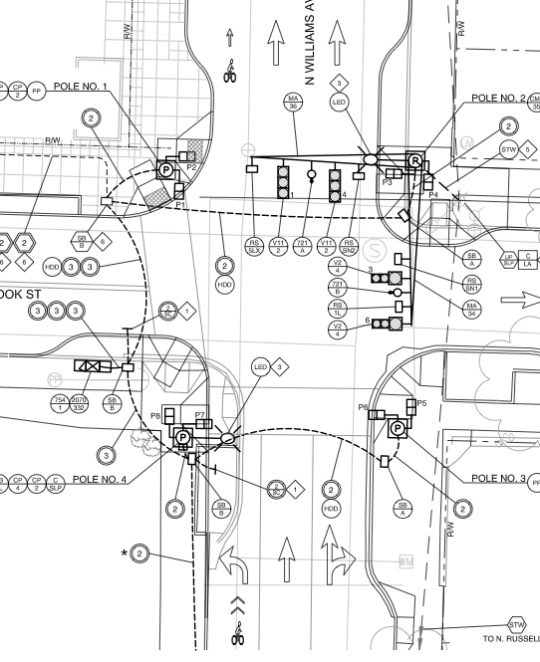
Green colored sections: Prior to seeing these plan drawings, we hadn’t seen exactly how PBOT would deal with potential conflict zones. Looks like they’ll paint six sections of green in the bike lanes (three of them in the high traffic blocks between Fargo and Fremont, including one at the main entrance to New Seasons’ parking lot) as well as three green bike turn boxes on cross streets (Tillamook, Russell, Going). These turn boxes will help people riding bicycles make a two-stage right turn from the bike lane on Williams toward the east. Instead of swinging right directly from the Williams bike lane, you’ll swing left into the turn box, re-orient yourself to the east, wait for a break in Williams traffic, then be on your way.
In the drawing below, you can see how PBOT plans to use two green-colored sections (black in the drawings) near New Seasons…
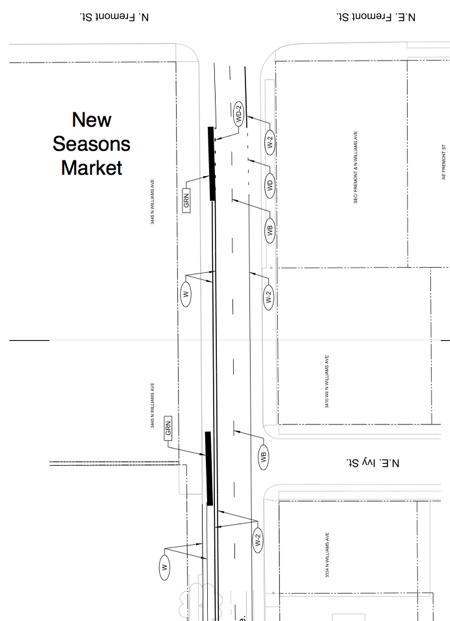
Lots of new curb extensions: Making good on their goal of improving walking conditions, the plans call for 14 new curb extensions. The intersections of Going and Failing will get a three curb extensions each. These will make crossing safer as well as calm traffic by narrowing the road cross-section. Check out the plans for the Going intersection:
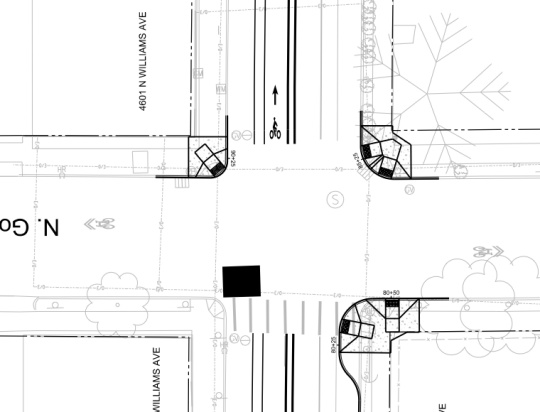
Bi-buffered bike lane: Most of the 30 (or so) block footprint of this project will have a relatively wide, seven-foot bike lane with painted buffers on each side. The bike lane will be to the left of just one standard vehicle lane, except in a few sections where there will be two lanes and the painted buffer drops into various types of mixing zones. We’ll get exact details on this at the event next week and report back.
Here’s a look at the block between Weidler and Broadway, where the buffered bike lane begins…
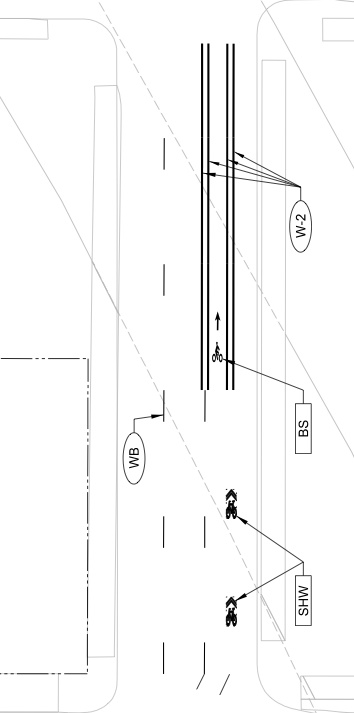
No physical separation or delineators?: We don’t see anything in these plans calling for delineators or other types of physical separation in the buffer zone of the bike lane. The digital renderings shown at past meetings showed plastic “candlestick” lane delineators, so we’ll ask about these at the meeting Tuesday.
Tillamook will be easier to cross: Tillamook is a key bike east-west bike route and as such, it will get some much-needed changes to make it easier to cross at Williams. Check the plans below to see the new zebra-striped crosswalk, curb extensions, and green bike box — all of which should calm Williams traffic while aiding people trying to get across it…w
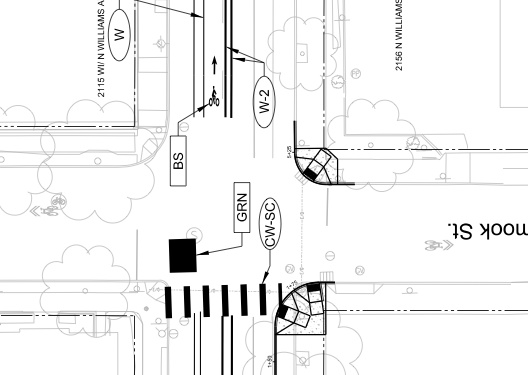
It’s exciting to see real progress on the changes coming to Williams Ave. At next week’s meeting, we look forward to hearing more about the “Honoring History” element of this project as well as the latest plans to re-design Rodney Ave, which is a popular alternate route just a few blocks east of Williams.
As for a timeline, PBOT expects to begin construction in late July/early August of this year.
Here are the meeting details:
-
Williams Ave Project Drop In
Tuesday, February 4th
12:00 to 1:30 pm
Legacy Emanuel Hospital, Room 1027 (entry via corner of N Gantenbein and Stanton)
Download a PDF of the plans here (44 pages, 8.7 MB).



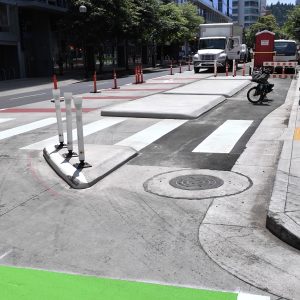
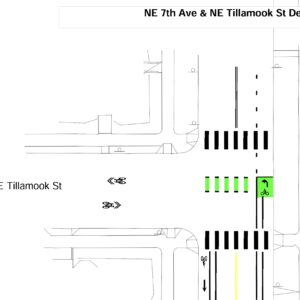
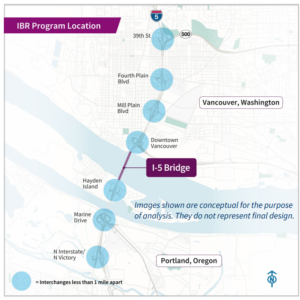
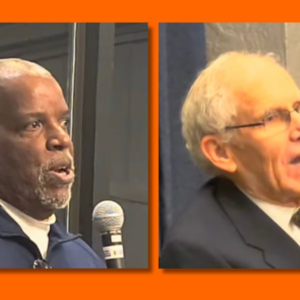
Thanks for reading.
BikePortland has served this community with independent community journalism since 2005. We rely on subscriptions from readers like you to survive. Your financial support is vital in keeping this valuable resource alive and well.
Please subscribe today to strengthen and expand our work.
It’s kind of tough to tell from the drawings — what are they doing to accommodate all the bikes turning right from Williams onto the Going greenway? Looks like what used to be a simple turn is going to involve merging across a lane of car traffic. Is that correct?
Carl. I just added a few words to the story because I didn’t make it clear initially. Those new green boxes are
leftright-turn boxes. People riding north in the Williams bike lane, would pull into one of the turn boxes and orient themselves to go west. They’d then wait for an opening in traffic, cross Williams, and be on their way.For Williams to Going specifically, if there isn’t physical separation (eg. if you’re not “suck” in the bike lane), I don’t see the turn boxes getting a ton of use during peak traffic times. I’m picturing what happens now during my commute on Broadway downtown with people darting from the bike lane across the other lanes to turn left (since the bike lane is on the right in this case).
I could be wrong but when Williams gets crowded, you could have 15 or 20 people on bikes all trying to cram into that little waiting area to cross over. Or they could ignore the box and take the lane a block or two early to set up for the right turn onto Going. My money is that the second scenario is what’s going to actually happen, while those shiny new green boxes stay empty.
After rereading this I’m even more confused. If you’re riding north up Williams, you’re already on the west side. Aren’t those *right* turn boxes, where you’d orient yourself to the east and then cross Williams?
Sorry David. My error. I had written “left-turn boxes” when I should have written “right-turn” boxes.
Ahh got it–thanks!
Are there any performance metrics to tell if this is actually an improvement? Eg, if enough cars drive in the buffered bike lane will there be additional changes? If fewer people bike on Williams than before will it count as a failure and trigger additional changes?
Yes, this. Would really like to know if they’re going to measure these things and more.
I don’t think many people will be into the two stage trun to go east on Going. I’m very likely to simply take the lane of auto traffic and turn right.
I think I’m just going to start using Rodney. It isn’t perfect, but it’s starting to look far easier than dealing with Williams.
So, the bike lane starts on the right side of Williams but eventually transitions to the left side? Or am I seeing these figures incorrectly? If not, how and where does the bike lane transition from the right to the left?
Hi Jonathan. It’s never really on the right side. Starting on the south end at Weidler, it’s sort of in the center before veering over the left north of Broadway. After that it’s on the left for good. Sometimes there will be on-street auto parking to the left of the bike lane, other times the bike lane is curb-tight.
What’s the etiquette for passing on a left side bike lane. It can’t still be ride right, pass left, can it?
etiquette schmetiquette. cyclists have the statutory right to safely pass vehicles (including bikes) on the right or left.
So, cyclists don’t have to follow the rules of the road?
It’s like you’re agreeing and disagreeing with Sparewheel simultaneously. “Statutory” was the keyword in Sparewheel’s comment. AKA the rules of the road. His comment should be interpreted as just that: cyclist can follows the rules of the road rather than be constrained by etiquette.
ORS 811.415 (truncated below)
(2) For purposes of this section, a person may drive a vehicle to overtake and pass upon the right of another vehicle under any of the following circumstances:
(c) Overtaking and passing upon the right is permitted if the overtaking vehicle is a bicycle that may safely make the passage under the existing conditions.
You can pass on the left as well, but I have a feeling you already instinctually know this.
What did you actually mean or try to say? It just seems like a broken thought. Nobody implied not following the rules.
This comes up on Hawthorne Bridge.
I guess the corridor bike shops should start importing right side helmet mirrors from UK / Japan. (I have looked all over the US and Europe for such for my Bell Metro helmet but no luck yet…)
I am still holding my breath on this project’s success (vs. the earlier pre-ruckus layout).
Buy a couple of my mirror kits for your gloves and put one on each hand…problem solved!
Note that there is only one curb extension added at Going – not three. Two of those are just corners reconstructed to meet current ADA requirements.
Looks good overall but two things bug me:
– A left-turn lane (3rd vehicle lane) is added at Cook. Bike lane is dropped here. So road capacity is increased, while bike facility is worsened. Not consistent with project intent.
– Two lanes are carried thru the commercial district (Cook to Skidmore). This is the place where people are walking in large numbers, and we should be making it easier to cross and slowing vehicle speeds for safety. This does not.
Maybe the local politics require this, but unfortunate nonetheless.
I’d be interested to see this fleshed out a bit more. I am still a bit confused by the drawings. Needless to say, I rode up N. Williams yesterday, around 3:30, and really felt that the current bike lane is more of a risk than what it was designed to mitigate. I had a large van pull up ahead of me, and cut me off when it parked on the right hand side. As I continued north near all the shops, countless people were in their cars with brakes or running lights on, and I was just waiting for a door to pop open at any second, while cars and trucks were passing me to my left. It was white knuckle bicycling to say the least. I often feel that way when I ride up there.I hope the improvements outlined above can be better for all of us who use this thoroughfare.
Are there plans for a light at Vancouver and Cook too? It’s a frightening mess there as well.
Yes there are plans for that. It’s outside the scope of the Williams project, so local business owners are working with the City to fund it and make it happen. I’ll learn more about that on Tuesday as well.
i really hope that they do not install bollards or candlesticks. they are unnecessary obstacles that inhibit safe passing and discourage mid-block access to businesses.
Where’s the plan to make Rodney a usable neighborhood greenway?
PBOT thinks Rodney is politically infeasible.
Not true.
Rodney seems very usable right now as it is, what’s the problem that you think needs to be solved?
transition at fremont
Why no protected bike lanes?
Those drawings are lovely but really aren’t moving the bar on separation between cars and bicyclists. No separation == no mode share change.
The current bike lane on Williams would beg to differ.
A platinum level city!
This is garbage. Other than the pedestrian improvements, it is basically a work out facility for the strong and fearless. I guess PBOTs strategy is to encourage everyone else to use Rodney because nothing attracts riders more than making them take less direct routes on dark side streets where there are fewer eyes on the street.
What is your problem with Rodney? It is a better route anyway, and I have never felt any safety issues there. Sure, Williams will be more comfortable for those who like to travel faster, but that is why Rodney is such a good alternative option, and the one I take most of the time.
1) Grade on Rodney is not as gradual and consistent.
2) You have to cross Fremont without a traffic signal on Rodney.
3) Rodney does not continue directly across Fremont, you have to jog.
4) All of the businesses and destinations are on Williams.
Yes, right now Rodney is less stressful than Williams, but a properly designed Williams that takes the so called 8-to-80 in mind would calm the environment on Williams. Who sad anything about going fast? I didn’t. I have a 10 month old (and another one on the way). I left any expectation to be able to do things quickly in the delivery room 10 months ago. My needs as a working professional and parent are exactly why I want a facility that is direct, convenient and safe. Williams as the primary northbound route for many commuters to N & NE Portland could be that. With this design, it will not be.
As far as safety concerns on Rodney (and other neighborhood greenways) go, I was speaking more generally about the lack of eyes on the street on the neighborhood greenways. If I remember correctly, someone was assaulted and possibly had their bicycle stolen while on Klickitat. I also have concerns about lack of maintenance of the street lights on these smaller streets. These things can happen on the main streets to, of course, but there is a better chance someone will be there to help.
The trouble with Rodney really isn’t ‘eyes on the street;’ I use it quite often because it’s a quiet, laid back, ride home in the evenings. The key trouble with Rodney is maintenance- it has a lot of little potholes just big enough to slam your lower teeth into your upper plate if you’re not careful; while not particularly dangerous, it does make for a sometimes jarring ride.
PBOT is actively putting people in danger by building a left-side door zone buffered bike lane. This is NOT the way to build a world-class cycling network. This project is garbage for cycling and should be scrapped for more removed parking and fully separated cycle tracks. Don’t try to sugar-coat this project.
How about we start calling this “door-side” instead of “door-zone.” Door-zone bike lanes are very specific conditions where a narrow bike lane is striped adjacent to a narrow parking lane – effectively forcing bicyclists to ride directly in the path of opening car doors.
On a 6 ft bike lane (or even better, an 8 ft bike lane) next to a full size parking lane, is it absolutely possible to ride within the lane without being in the path of opening doors. These are door-side bike lanes, not door-zone bike lanes.
Bike lanes have a place in our city, and if they are appropriate anywhere it is on a street with only one lane of relatively slow moving traffic.
I think these are still “door-zone” because the majority of the bike lane is in the door zone (which I count as four feet due to bad parking and wide doors on coupe-style cars). Additionally, the majority of bikers will likely bike in the door zone, rather than in the uncomfortable two outer feet next to heavy auto traffic (at rush hour). Just take a look at where people bike on Hawthorne between SE Grand and SE 12th.
Sure, six-foot door-zone bike lanes are better than four-foot ones. But eight-foot is the minimum width I would consider for the “door-side” moniker, and then only if the door zone is marked (e.g. with diagonal lines) to indicate (to people driving as well as people biking) that the door zone is not to be used for biking.
But all these varieties of bike lanes seem like half-measures and workarounds compared to installing real cycle tracks. And educating drivers and passengers to look for people biking before opening their doors (use the awkward hand!)
“the majority of the lane”
please explain your math. i see virtually no overlap with the door zone.
i’m also really trying to understand why you feel that we need cycletracks everywhere. danish best practice recommends cycle tracks only for higher-speed roads (50-60km/h):
http://www.copenhagenize.com/2013/04/the-copenhagenize-bicycle-planning-guide.html
i should also add that the single narrow vehicle lane being proposed for williams will almost certainly be swarmed by cyclists and peds resulting in even more de facto calming of the bull. a curb or further separation would inhibit this natural traffic calming, imo.
Spare Wheel, the graphic you linked to shows painted bike lanes being placed on the curb side of cars, including at motor vehicle speeds of 30 km/h (19 mph). If we were doing that on this road, I would call it a cycle track and be happy (if proper infrastructure were put in place to avoid right/left hooks). But we’re not, so I’m calling it a bike lane and saying it’s not good enough. Certainly better than what we’ve got, but not good enough.
and the chart also shows conventional bike lanes from 30-50 km/hr. 50 km/hr seem a bit high to me but that is *best practice* in denmark. do we really need to go above and beyond denmark on a congested and narrow 1 lane road when we have so many dangerous arterials with no infrastructure mitigation?
Are you looking at a different chart? When I look, I see conventional bicycle lane for 40 km/h (~ 25mph) and curb separated bicycle lane for 50-60km/h (roughly equivalent to American streets of 30 and 35mph).
That really is a confusing figure. The words underneath it are probably more helpful.
Great points.
Here in SF I like to call the wider doorzone lanes Double Parking Lanes, because that is exactly that they all become before the paint even dries.
Not sure how pervasive the problem is on a daily basis city-wide in Portland, but it’s epidemic in SF. As Portland densifies yet keeps conventional modeshare proportions intact (meaning many many more new cars in the same space) that will only make the problem worse.
The wider those conventional lanes get (especially when they’re “buffered” by paint–adding even extra width) the more they approach and often even exceed the width necessary for a car, delivery truck, garbage truck, mail truck, etc. to fully just squeeze on in there and double park “for just a few minutes while I drop this off.”
These designs so blatantly encourage bad car behavior that even upped enforcement will never catch anything more than a tiny percentage of infractions.
It’s astounding these things keep on getting recommended and unconscionable they keep on getting built.
Even the po-po can’t resist parking in them sometimes for clear non-emergencies:
http://sf.streetsblog.org/2014/01/23/whos-parking-in-the-fell-street-bike-lane-today-oh-its-sfpd/
If this already isn’t a problem to some degree as Portland is densifying let SF’s subpar bike infrastructure in a denser context be a stark warning of what low modeshare+many more cars in the same amount of space+bad infrastructure can do.
Totally agreed.
Now that federal NACTO/FHWA guidelines even endorse cycletracks (although with some big fundamental flaws, but let’s ignore that for a second) I wonder at what point legal action against these bad designs will be the only thing that makes communities take notice.
As in…there are now demonstrably better and safer designs that are not even considered “experimental” anymore and they *still* chose to go with proven, more dangerous infrastructure.
Absolutely. This is what needs to be reinforced again and again. It’s one thing to make do with current conventional bike lanes. As people who’ve already decided to bike we all do.
But when an area newly comes up for redesign, why spend the time and money implementing proven dangerous infrastructure and proven modeshare un-boosters?
Conventional bike infrastructure in between moving and parked cars, no matter how “paint buffered” or supposedly “out of the doorzone” it is (see Double Parking Lanes comment above), simply almost never significantly boosts modeshare.
People interested in trying biking to get around simply won’t touch ’em.
Actually, as far as I’m concerned for the most part we should be ignoring Denmark altogether.
The increasingly divergent practices of the Netherlands and Denmark are a perfect case study as to why. Back 20+ years ago both the NL and DK were in a relatively similar situation bike-infrastructure-wise.
But since then while the NL has consistently built better and more protected infrastructure (including more protected lanes in general as well as innovations such as protected cycletrack intersections as opposed to the third-rate and much more dangerous Copenhagen Lefts still inexplicably being implemented in Denmark and sadly being copied here in the US) Denmark has mostly stagnated.
Copenhagen’s modeshare for all trips is currently in the low-mid 20s and has actually been declining as more residents are reporting feeling less safe on the bike infrastructure.
http://www.aviewfromthecyclepath.com/2009/12/truth-about-copenhagen.html
For all its self-promotion and marketing about being Bike Mecca, Copenhagen’s modeshare is much lower than almost any even *underperforming* Dutch town or city. In the NL a bike modeshare under 30% is considered unacceptable and communities implement improvements to nudge it up. And the under-30-percenters achieve it through better infrastructure.
In conclusion, I wouldn’t be looking to Denmark for any particular advice about where or where not to build protected infrastructure–sure, their infrastructure is better than that of most in the world (though that is setting the bar quite low) but the data show Denmark’s infrastructure is not by any means “best practice.”
My point again is if we’re spending the time and money to *redo* a street in the US, why are were aiming low by emulating third-rate solutions? It’s troubling that even a place like Portland is still doing this, to be frank.
In my experience, double parking is pretty much non-existant (except maybe in select areas of NW or a few hotel areas downtown)
The cabbies love to double park on E Burnside Grand to about 10th. I would agree, though that the rest of the city it isn’t much of a problem.
considering that your handle is a dutch expression i will take your criticism of danish cycling facilities with a big grain of salt.
Math: bike lanes are 6′ or 7′ wide. Door zone is 4′. That is the majority of either 6′ or 7′, leaving only two or three feet for biking. The part that’s good for biking is sadly next to heavy rush-hour traffic.
you are mistaken. those bike lanes are no where near 6-7 feet wide.
don’t you live in chicago, adam?
Yes, does that invalidate my opinion?
If you have little knowledge of the compromises involved in the project and that not 100% of people in the city are excited about this project, then yes it does.
BikePortland does a good job of covering this project. Do I physically need to see the street in order to express my thoughts on the project?
When you don’t live in the city (and have little vested interest) and throw out “this is garbage for cyclists”, than yes, you probably should have at least ridden the section before. I wouldn’t begin to go on a forum about Chicago biking and throw out judgements about their local infrastructure (and then argue about it with people who actually live there and use it every day). Not all cyclists want separated cycletracks, it’s a complex issue.
It’s not really that complex of an issue. It doesn’t matter if some “cyclists” don’t want separated cycle tracks. Their whole point is to attract people who want to ride a bike for transportation but are too nervous about safety, given current infrastructure. SepRated cycle tracts have been proven to increase safety. We shouldn’t let a handful of “hardcore cyclists” dictate safety standards for a whole city.
The only way to increase bike mode share (and that’s Portland’s ultimate goal, right?) is to build out safer bike infra, not some slightly better bike lane that only will attract the people who already ride.
i can’t even begin to count the strawmen in your post. but at the very least i should point out that mode share in germany has increased at a faster rate than in any other european nation during a period where segregated lanes were removed and replace with door zone free bike lanes. and it’s not that i or daverness do not want separated cycle tracks. i just don’t think they are appropriate everywhere. i vociferously advocated for a cycle track on foster on bike portlan. i am also excited about the plans for a cycle track on SW multnomah. if pbot actually builds this facility — it may very well be the first truly world-class cycle track in north america. on the other hand, i am most definitely not excited about the north american bike sidewalks pbot has installed on broadway and cully. these facilites are worse than a conventional bike lane.
i also want to point out that i know you are from chicago becuase i’ve noticed you spamming just about every bike blog i’ve ever visited with repetitive pleas for protected bike lanes. this type of behavior reminds me of the VCers of yore — one “solution” to every infrastructure problem.
Yet the current bike lane on Williams has seen an explosion of cyclists of exponential proportions the last 10 years (certainly a lot of this is due to changing neighborhood dynamics), which clearly demonstrates that there are people who are willing to use bike lanes, and bike lanes ARE capable of increasing mode share.
And yes, all street projects are “complex issues” made up of dozens of different stakeholders with totally different perspectives and priorities. I didn’t fully appreciate this until I started attending the SAC meeting for SE Foster last year. Then you will start to realize what a give/take these projects really are. Do they have the funding for the extra cost cycle tracks will be? Do they have the extra space? Can they safely be implemented in this area (there are quite a few cross streets, which are always trouble for harder to see cycletracks)?
Let’s just say it would help if you’ve actually ridden over the streets in question.
Hey!! Someone who GETS it!!
the williams bike lane appears to have buffers on both sides. Also, since most autos have single occupants, the left side doors are opened more than right side. Buffered bike lanes on the left side should result in less potential for dooring and separates bike path from right side of the road bus stops. PBOT does not actively put users in danger. PBOT evaluates different alternatives and does the best it can with the funding available.
I am concerned about the Eastbound Wiedler to Northbound Williams transition.
How does a person continue on N Willams in a car (or bus 44, 4)? They have to cross the bike lane within green painted section.
Anyone who rides often on Wiedler near MLK knows how well people handle crossing a bike lane to get to the far right lane. About 50% yield for bikes.
Are traffic signals going to change to have a section of bike-only traffic?
Right now the center lane on Williams south of Broadway is a dealer’s choice. the motorist can go north on Williams or take the ramp to the freeway. Placing the buffered bike lane between the two left lanes (that must go to the freeway) and one right lane should be safer. the space north of Broadway could even get some delineators to deter crossing over.
Motorists going east on Weidler and turning north to Williams should not be crossing the bike lane when cyclists are present, and will likely enter the lane in the first 30 feet. Cyclist on Weidler are on the south side and use a jug handle path to get to northbound Williams south of Weidler. So cyclists move on a different cycle than motorist entering Williams.
Lastly, PBOT is working on a Weidler to northbound Flint alternative path that would get you to Russell and avoid much of the ‘box’.
Where can we learn more about this Weidler to northbound Flint alternative?
“a Weidler to northbound Flint alternative path that would get you to Russell…”
Hallelujah. I’ve witnessed two close calls with drivers running the red light on Weidler crossing Williams. I’m talking where the Williams light has been green for 3 or 4 seconds and someone comes sailing through the red. The last was just two evenings ago and the rider two feet in front of me nearly got creamed. Three of us in mid-intersection and I couldn’t tell if the driver ever even saw us, he/she never flinched, fortunately for us being in the leftmost lane. Even worse, cars in the center two lanes had stopped at the light and this person drove right past them! I’ll be glad to avoid that intersection in the future. Be careful out there.
Thanks for the informed response!
Reading the document, I hadn’t realized that there was the rightmost third lane between Wiedler and Broadway. That makes more sense.
People turning left onto Williams will not be interacting with as many bicycles, and the people continuing up Williams will likely be behind the cyclists. A bike-only green would make sense on Williams at Wiedler to give folks on bicycles a head-start.
My mind boggles at what a Northbound Flint route would look like. Does it involve flyovers (preferably multiple)?
many options abound. there’s a signal where the westbound broadway u-turn to weidler is. That is the proposed weidler crossing. a signal is planned at broadway and wheeler, where the City closed wheeler on the north side of Broadway. That is the Broadway crossing. From Wheeler to flint is straight forward – shared path or contra-flow to Flint. Between Broadway and Weidler there are a couple options at least. One is shared path north side Weidler to Wheeler. The other is to repurpose the u-turn lane into an eastbound bike only lane. westbound auto users would be sent west to Benton for Rose Quarter access or u-turn to Weidler.
I am so glad we are all concerned about the safety and convenience of cyclist. I live in N Portland. Williams/Vancouver is my neighborhood street. I-5 N is congested with people communing to Vancouver. That leaves me, Williams, Interstate, MLK. Interstate is clogged because it is down to one lane due to the Max. MLK is reasonable, Williams gets slower and slower buy the day. Now due to it being changed to one lane, it will be come as useless to drivers who live in the neighborhoods as Interstate is. I want to pick up my children, from their schools, perhaps pick up a few necessities for dinner and maybe visit the library all before 6 pm. Not going to happen…….
You could easily, as many many people do in that are, do all of that on a bike with ZERO delay. The traffic, even if lanes were added, will continue to just get worse. #justsayin
Going to one lane could even have the interesting effect that drivers that live nowhere near the area stop using it as a way to get to I-5 and such, creating a more local street. This could then allow you to do what you just stated – by car. not that I’m suggesting you should use that mode.
So, were actually losing a lane? Some blocks the lane is only dashed on the RH side. What a mess this is. Not sure why PBOT feels it necessary to constantly reinvent the wheel with regard to bike lanes. See: Cully, Multnolmah, Upper SW Broadway.
They’re reinventing the wheel because the wheel is broken.
Out of those 3 protected bike lanes, do you have a favorite? Or do you prefer the conventional bike lane design?
I would say the standard Vancouver/Williams lane is fine with me. Fast efficient and smooth. All the other types confuse drivers and I have little faith in them to learn new arrangements especially if only for a few blocks.
Exactly.
Cities such as Portland or SF that talk the talk of wanting to boost bike modeshare to 20-25%+ at a fundamental level need to be thinking not just about the comparatively small percentage of people who currently bike but about how to draw in the many people who don’t currently bike to get around, but would do so if it were safer (both in reality and in perception).
Separated infrastructure is demonstrably safer and boosts modeshare in a way conventional lanes just don’t, especially the more pervasive it becomes. Conventional lanes are ignored white noise to most people, but they will take notice of separated infrastructure.
“separated infrastructure is demonstrably safer”
nonsense. just about every large study of segregated infrastructure in europe finds increased risk versus non-segregated infrastructure. even dutch separated facilities are associated with more hospitalizations than non-separated dutch facilities.
I find that hard to believe. Do you have any evidence to support this claim?
i suggest you google the multiple studies by jensen et al.
here is one example:
http://trafitec.dk/sites/default/files/publications/bicycle%20tracks%20and%20lanes.pdf
(a before after study that corrects for traffic volume)
jan heine has a summary of some of additional work here:
http://janheine.wordpress.com/2013/05/21/separated-cycle-paths-a-summary/
more on why the german cycling federation rebelled against cyclepaths and demanded door zone-free bike lanes:
http://janheine.wordpress.com/2013/07/12/cyclepaths-in-berlin/
a visit by a pbot stafffer to munich:
http://livablestreet.wordpress.com/2011/11/07/182/
more detailed studies and reports (many in german):
Summary:
http://www.uni-due.de/~sld68wi/Radwegesicherheit.pdf
http://www.adfc-nrw.de/kreisverbaende/kv-bottrop/radverkehr/sicherheit-von-radwegen.html
Der niederländische Fietsberaad musste dem Verkehrsministerium zuletzt mitteilen, dass im Jahr 2006 von allen in ein Krankenhaus eingelieferten Verkehrsunfallopfern 40% Fahrradfahrer waren.
Full text:
http://www.uni-due.de/~sld68wi/Radwegesicherheit_Druck.pdf
http://www.adfc.de/presse/pressemitteilungen/neufassung-der-stvo-zum-1-april
Compressed pdf:
http://www.adfc-bw.de/texte/fdf.zip
http://www.bast.de/cln_005/nn_42640/DE/Publikationen/Fachliche/Berichte/unterreihe-v/Functions/Berichte-V,param=2.html
http://bernd.sluka.de/Radfahren/rechtlich.html
the infamous berlin police study that determined that separated paths were actually less safe than in lane facilities:
http://www.berlin.de/polizei/verkehr/liste/archiv/28671/index.html
You left out a part: “Separated infrastructure is demonstrably safer and boosts modeshare IN EUROPE in a way conventional lanes just don’t”
The jury is still out on this in the US, so I don’t think you can quite call it a fact yet.
All the good Danish expressions were taken so I was forced to choose a Dutch one 😉 …close enough!
In more seriousness, though, I’m not some crazed Everything-Dutch-Is-Awesome guy. In fact, as great an experience as it was living there I decided for various reasons it wasn’t for me long-term. And even when it comes to bikes/urban planning I do not hold every Dutch position sacrosanct. I’ve mentioned before I strongly disagree with their allowance of mopeds on cycletracks and I also think it’s a backwards step for cities like Amsterdam to offer free parking to electric vehicles, for example.
We should not copy those Dutch policies.
Similarly, we should not spend time and money copying second-rate bike infrastructure, wherever it comes from. One of the places it happens to come from is Denmark. As for the post I linked criticizing Danish infra (http://www.aviewfromthecyclepath.com/2009/12/truth-about-copenhagen.html) that guy’s British, so he can hardly be accused of blind Dutch patriotism, either. He references lots of cold hard numbers backing up his statements.
Btw, even the Danes are starting to admit their infrastructure is what’s behind their lagging cycling numbers:
http://politiken.dk/kultur/ECE2160068/koebenhavn-trues-af-cykelivrige-hollaendere/
English translation: http://translate.google.com/translate?hl=en&sl=da&tl=en&u=http%3A%2F%2Fpolitiken.dk%2Fkultur%2FECE2160068%2Fkoebenhavn-trues-af-cykelivrige-hollaendere%2F
All those points are well-addressed here:
http://www.aviewfromthecyclepath.com/2010/05/just-how-safe-are-dutch-cyclists-and.html
The data alone show separated facilities are safer, and this isn’t even mentioning the perceived safety of separated infrastructure as a modeshare-booster.
my points about safety are not addressed by hembrow at all. i was referring to before/after studies conducted by soren jensen (comissioned by CPH transportation authorities). moreover, hembrow’s attempt to argue that collisions which require a hospital trip are “minor” is risible. in fact, one of the main reasons germany started to decommission cycle tracks was because repeated studies (in germany, the netherlands, and belgium) showed that dutch-style cyclepaths increased injury risk (especially at intersections). germany represents the achilles heal of the dutch/danish cycling hype — a nation that has experienced massive increases in mode share, has very high levels of ped/cyclist safety, and little segregation.
i would also like to point out that hembrow earns his income by working as an advocate/lobbyist for dutch cycling. i read and appreciate his blog but he is about as biased as one could possibly be when it comes to infrastructure advocacy.
yes, please do not mention “perceived safety as a modeshare booster,” a/k/a luring people to their death
i would hope portland’s “ultimate goal” is to allow people to travel safely, with yes, some emphasis on modes other than private automobile.
there may be places where separated facilities are workable. right here, on williams, right now, something needs to be done to accommodate existing uses safely, i.e., “the people who already ride” a very highly trafficked corridor at speed, and those who are trying to cross the street on foot. and the proposed design will quietly put some downward pressure on automobile volumes as well.
increased mode share beyond dealing with this immediate problem is more likely to be focused on rodney.
The thing is, though, that pretty-good unseparated (in other words, conventional) infrastructure in the US has already been tried–in some cases for decades–to underwhelming results. To say the least.
Some American communities have been doing the Bike Boulevards+conventional lanes approaches since the 70s. These are certainly not bad things, per se, but have not led to impressive modeshare shifts. Experience in these real-life test cases shows these approaches alone don’t form a comprehensive-enough approach.
This even in (mostly) flat places with (mostly) favorable weather and mindsets culturally open to and approving of non-car movement. Berkeley comes to mind. But even Berkeley, long associated with the US Bike Boulevard movement, has in recent times begun to realize its Bike Blvds and conventional lanes (and it has built many that are doorzone-free for some time now) are simply not enough and is focusing new efforts towards separated infrastructure.
German cities still have modeshare far below what any ambitious city aiming to get out of the 10s should be shooting for:
http://www.nationaler-radverkehrsplan.de/en/transferstelle/downloads/cye-a-09.pdf
Those modeshare percentages (Berlin 13%, Munich 14%, Hanover 15%, etc.) are pittances compared to any municipality in the Netherlands. And none reach the 25% goal Portland has set for itself.
The few exceptions in Germany with high modeshare, such as Münster, have unusually high (by German standards) proportions of separated infrastructure than their other German brethren, and what’s worth noting is the huge growth of their bike culture is recent:
“It is important to note that Münster lacked a significant cycling culture until recent times. It was developed newly, in a pre-existing urban environment, from the 1980s, through good infrastructure and planning, which owes quite a bit to the Dutch model, the Dutch border being only 40km distant. However, the cycling infrastructure in Münster is not up to Dutch standards of convenience and capaciousness, it is not as continuous, and sometimes it shows design flaws and problems of enforcement that you would not see in the Netherlands.”
http://www.voleospeed.co.uk/2013/03/two-university-cities-cambridge-and.html
(some picture examples of Münster’s separated infrastructure).
It doesn’t seem very likely that many people like him go into bike-infra advocacy for the money. To me his observations and reports read to as the sincere words of someone who’s convinced both by experience and data (which he readily provides) that much of what the Netherlands has been doing is best practice.
your numbers are outdated. germany now has ~15% mode share on a national basis with some city areas approaching ~50%.
http://www.ecf.com/news/cycling-solutions-why-germany-has-all-the-answers/
But this report even concludes:
Construction of bicycle tracks resulted in a 20 percent increase in bicycle / moped traffic mileage and a decrease of 10 percent in motor vehicle traffic mileage, whereas marking of bicycle lanes resulted in a 5 percent increase in bicycle / moped traffic mileage and a decrease of 1 percent in motor vehicle traffic mileage. The changes in traffic do result in health benefits due to more physical activity, less air pollution and less traffic noise. The positive benefits may well be much higher than the negative consequences caused by new safety problems.
So this study concludes that the modeshare-increasing of protected infrastructure is
A) very real
and
B) is probably worth any new safety problems due to increased numbers out there.
And this study only examines *Danish* cycletrack intersections, which are indeed generally comparatively dangerously designed and not best practice.
However, the Dutch design assumes that both car and cyclist arrive at the intersection when the light is red. Most drivers and cyclists try to time it so that they arrive when the light is green. In that situation, the cyclist again can find themselves behind the car, and close to invisible.
I know he’s based in Seattle but it would seem Jan might benefit from more time visiting the exemplars in the country next to his native one. Through smart design and timing this is almost never a problem in the Netherlands. In my experience it *is* a common problem with the designs in Germany.
Another problem with separate paths is the inconvenience to the cyclist. Where a car driver can go straight, the cyclist has to make a right, a left, another left and finally a right turn to negotiate the intersection. And if the cyclist wants to turn left, she has to wait an extra light cycle, since she has to cross two traffic lights instead of one.
Light-timing and better physical design mean this is almost never a problem in the Netherlands.
I almost never felt inconvenienced by those designs while living and biking daily in the Netherlands, probably due to the good timing. Never even crossed my mind. I *did* notice the problem in Germany.
Even ignoring the glaring safety issues, many don’t consider vehicular-cycling lefts on busy roads in the US particularly “convenient” either.
These are definitely valid criticisms of archaic subpar cycletracks in Germany, not representative of cycletrack best practices. Of course those shouldn’t be mimicked.
But to me that’s kind of like saying that because you experienced subpar, demonstrably flawed (maybe even unsafe? haha) food at the Olive Garden you recommend everyone avoid all Italian food from now on and switch over to hamburgers.
Again, these are definitely valid criticisms but of archaic subpar cycletrack designs.
Yes, but that’s surely *because* Dutch bike modeshare is so high in the first place. It comprises a higher proportion of all physical activities in that country relative to other countries.
Similarly, I’m sure that hockey-related injuries comprise a higher percentage of hospital admits in, say, Ontario than in California. Does that mean the Canadians are inherently doing hockey wrong? Probably not. Probably just means many more of them are playing it. I’m guessing their surfing-related hospital admits are lower than the rates California hospitals experience.
Or, for another example it’s kind of like those alarmist headlines that laptops now represent a much higher percentage of all police reports of stolen goods in the US than they did in 1990. Well, there are lots more of them now.
A much fairer look is at per-capita and per-kilometer figures. No matter what stats you look at the Dutch ones are always lower than Germany’s.
“U.S. cyclists are three times more likely to be killed than German cyclists and six times more than Dutch cyclists, whether compared per-trip or per-distance traveled (7).”
http://www.sharetheroad.ca/what-are-the-dangers-in-terms-of-cycling-safety–p128277
More related to the numbers-traveled factor:
http://www.aviewfromthecyclepath.com/2010/08/brain-injuries-and-dutch-cyclist.html
Just as a suggestion. I get that you have a lot to say, but you might want to break it up into readable segments, and actually reply to posts you want to address. Your incredibly long posts are well thought out, but kind of hard for most to digest.
i believe the increase in mode share for cycle tracks was versus no infrastructure.
i’m not interested in dissing dutch infrastructure. it works well in the netherlands. the question in pdx, however, is what type of infrastructure will best maximize increases in mode share. i believe that in many cases buffered bike lanes (and traffic-calmed bike boulevards) provide much better bang for our transportation dollar than more expensive protected facilities. (protected facilities should be a part of our tool set but we should also consider other options when they further connectivity and efficiency.)
I know signals are expensive, but increased signalization is a useful tool. Especially if they are timed to flow traffic at 20 mph. Eugene had this through downtown on HWY 99; there were signals on nearly every block, so 99 was easy to cross, but if you putted along at 20 mph, you rarely needed to touch your brakes. Very calm and safe. Vancouver Williams would benefit from that b/c motorists would soon learn there was no benefit to racing from signal to signal, changing lanes and jockeying for position. The slow speeds might deter I-5 diversion and be good for the businesses, bikes and peds, too.
I don’t know if everyone is capable of learning that though. I bike through downtown once or twice a week and I’m still in awe of the cars that will always gun it on a green only to slam on their brakes at the next intersection (for the entire length of 4th!).
The stoplights on N. Cook and Williams are to be paid for by the developer (Ben Kaiser) building east of New Seasons on Fremont and Williams – as were mandated by the City Council. He can’t build his 85-foot big until the lights are in and paid for. Could this derail the entire project? Plus how much traffic will 120 living spaces and a dozen new business add to the cluster corner at Fremont?
When every vacant lot is built up around New Seasons, Vancouver/Williams/Fremont will feel like a city…congestion, slow (but safe traffic), lots of pedestrians and bikers. Bring it on!